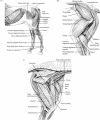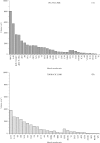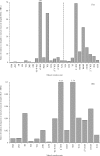Functional specialisation of pelvic limb anatomy in horses (Equus caballus)
- PMID: 15960766
- PMCID: PMC1571521
- DOI: 10.1111/j.1469-7580.2005.00420.x
Functional specialisation of pelvic limb anatomy in horses (Equus caballus)
Abstract
We provide quantitative anatomical data on the muscle-tendon units of the equine pelvic limb. Specifically, we recorded muscle mass, fascicle length, pennation angle, tendon mass and tendon rest length. Physiological cross sectional area was then determined and maximum isometric force estimated. There was proximal-to-distal reduction in muscle volume and fascicle length. Proximal limb tendons were few and, where present, were relatively short. By contrast, distal limb tendons were numerous and long in comparison to mean muscle fascicle length, increasing potential for elastic energy storage. When compared with published data on thoracic limb muscles, proximal pelvic limb muscles were larger in volume and had shorter fascicles. Distal limb muscle architecture was similar in thoracic and pelvic limbs with the exception of flexor digitorum lateralis (lateral head of the deep digital flexor), the architecture of which was similar to that of the pelvic and thoracic limb superficial digital flexors, suggesting a functional similarity.
Figures






References
-
- Alexander RM. Animal Mechanics. London, U.K.: Sidgwick and Jackson; 1968.
-
- Alexander RM. Allometry of the limbs of antelopes (Bovidae) J. Zool. 1977;183:125–146.
-
- Alexander RM. Tendon elasticity and muscle function. Comp. Biochem. Physiol. A. Mol. Integr. Physiol. 2002;133:1001–1011. - PubMed
-
- Alexander RM, Jayes AS, Maloiy GMO, Wathuta EM. Allometry of the leg muscles of mammals. J. Zool. 1981;194:539–552.
-
- Bennett MB, Ker RF, Dimery NJ, Alexander RM. Mechanical properties of various mammalian tendons. J. Zool. Lond. 1986;209:537–548.
Publication types
MeSH terms
LinkOut - more resources
Full Text Sources

